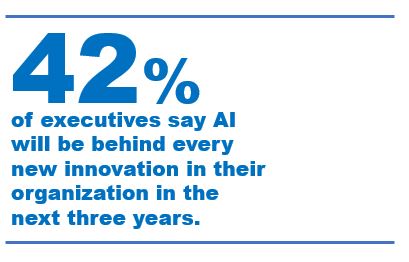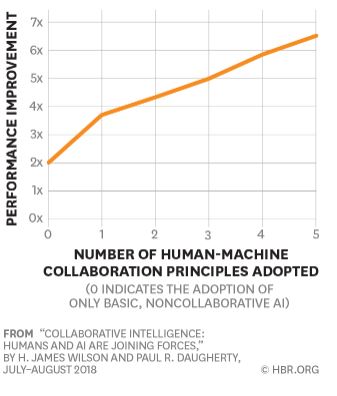Part 1 of this series validated the transition to applications of artificial intelligence in all industries, in businesses of all sizes, and globally. We documented that the rate and degree of that transition will continue to increase through 2030. It will impact both the nature of how business is done and how the work performed to do the business will be transformed. Part 1 focused directly on the impact on the workforce itself.
Part 2 details workers’ reactions to workforce changes and examines how companies can make workforce transformation complement the unquestioned technological transformation. It also focuses on strategies for companies to enable humans to work with AI effectively.
Workers’ Reaction to AI
 Workers have already accepted the arrival of AI in their workplace. The initial fear that AI and automation would reduce the number of jobs across industries has abated. In fact, the prospect of new skills and new opportunities generates positive survey responses by employees likely to be affected.
Workers have already accepted the arrival of AI in their workplace. The initial fear that AI and automation would reduce the number of jobs across industries has abated. In fact, the prospect of new skills and new opportunities generates positive survey responses by employees likely to be affected.
Overall, workers are aware that new skills will be needed (67%) and almost as many believe that AI and those skills will positively affect their work (62%). Almost half respond that AI will improve their work performance (45%).
Companies’ Necessary Reaction to AI and the Workforce
The Brookings Institute reported in detail how automation and AI affected workplaces and workers as of January 2019.
The AI era of automation will …… accelerate … the disruptive process of task creation and destruction. This acceleration will require workers to develop a constant learning mindset and use it to work both with machines, and in ways machines cannot.
This report recommends that companies provide employees opportunities for accelerated learning and certifications. This approach enables workforces to meet the accelerated pace and increased extent of changes in the work performed. Through these modalities, workers can acquire skills quickly and inform employers of the skills acquired.
Accenture’s conclusion in their previously noted Reworking the Revolution is that companies should look to the specific skills required, not to the old way of doing things. Almost every work assignment that engages robots, machine language, or AI decision-making will require new and different collaboration skills by the human workers. For instance, as AI software redesigns aircraft for greater strength, lightness, and economy, human co-workers continually direct and re-direct the software through millions of concepts to create the desired result.
 There will also be overall changes in the types of roles and responsibilities humans have in AI-populated workforces. Although produced in 2017, the Accenture Future Workforce Ethnographic Study’s projections of changes in types of roles remain viable.
There will also be overall changes in the types of roles and responsibilities humans have in AI-populated workforces. Although produced in 2017, the Accenture Future Workforce Ethnographic Study’s projections of changes in types of roles remain viable.
IFTF and Dell Technologies’ partnered report, Future of Work, makes clear the role companies will have in preparing workers for the AI-driven workplace…
The future of work is inextricably linked to the future of learning. How we educate our youth translates into their preparedness as they enter the workforce. And how we retrain and upskill our existing workforce allows them to stay relevant in a changing work environment.The learning, retraining and upskilling over the next decade will include improving everyone’s knowledge of and capabilities in AI. And this won’t necessarily mean teaching coding or even broader technical skills. In a new world of work, learning to effectively judge what machines can and cannot do, as well as what they should and should not do, will be a critical capability for workers in the future. In return, human strengths and capabilities will need to be integrated into AI systems to help workers partner more collaboratively with them. Classifying the strengths and capabilities of both humans and machines will be a core aspect of having a strong command of AI systems in the future.
The need for mutual collaboration in human-machine partnership is clear. Workers who are fluent in AI will know the limitations of AI systems, and how to maximize use of AI to accomplish tasks and produce desired results. Future of Work goes a stride further and states that by 2030, AI systems will likely have a “human fluency” to identify which tasks are better left to humans. The conclusion is that “keeping pace with how each other’s evolving capabilities might be changing will be part of building fluency in AI.”
H. James Wilson and Paul R. Daugherty make a strong case for collaborative intelligence, by which humans and AI complement and enhance their respective skills.
To take full advantage of this collaboration, companies must understand how humans can most effectively augment machines, how machines can enhance what humans do best, and how to redesign business processes to support the partnership.

Human skills and AI skills complement each other. With the right skills, humans can support and even improve AI functionality. Here are three such human skills with which companies need to prepare their workers:
- Train AI to do the work desired, such as recognizing human expressions, detecting disease, supporting financial decisions, and interacting with humans in optimal ways.
- Explain to those not expert with AI the behavior and processes by which AI generates conclusions and actions.
- Sustain AI systems within the responsible, safe, and appropriate parameters of their functionality.
Wilson and Daugherty also cite three ways in which AI will expand human abilities. Each offers a positive development of specific worker competency. Smart machines are increasingly able to
- Amplify analytics and decision-making by offering the right information at the right time. Imagine feeding data criteria to an application capable of offering countless designs – window frames, for instance. While AI performs the calculations, the human applies professional judgement and aesthetic sensibility.
- Interact with employees and customers in innovative, effective ways. Consider auto-transcribing, voice search, and chatbots as examples.
- Embody context-aware abilities allowing the collaborative robot (cobot) to work cooperatively alongside humans. For example, a cobot that folds and tapes cardboard boxes frees the human worker to monitor, adapt, and redirect the assembly process.
Companies intent on digital success in 2020 and beyond must tend to both skill sets: the skills the human needs to strengthen and safeguard AI engagement and the professional development the human gains from working with smart machines.
Summary: Action Items for Planning
Planning for technological change must include attention to changes that impact the workforce and how to make those changes not only acceptable but favorable to those most affected. The workforce is most affected immediately by the global transition to AI and automation. We suggest these four actions for every business experiencing or expecting introduction of artificial intelligence.
- Thoughtfully project the degree and rate that AI will increase within one’s company
- Identify the specific changes AI will generate by changing the assignment of tasks: machine tasks as opposed to cognitive tasks
- Open communications to learn how workers anticipate the shift to AI
- Prepare for ample opportunities for employees to learn and develop skills and acceptance relevant to human-machine partnerships
How well are humans and AI joining hands in your organization?


